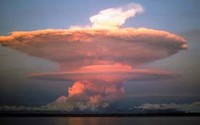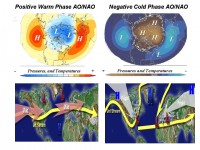By Dan Joling, AP News, January 30, 2008
Hardware stores and auto parts shops scored a post-holiday run of business this week as Anchorage-area residents stocked up on protective eyewear and
masks ahead of a possible eruption of Mount Redoubt. Monitoring earthquakes underneath the 10,200-foot Redoubt Volcano about 100 miles southwest of Anchorage, scientists from the Alaska Volcano Observatory warned that an eruption was imminent.

Mt Redoubt when it last erupted in 1989. See a larger image here.
Peter Cervelli, a research geophysicist with the observatory, told CNN that “every indication is that we’re heading toward an eruption.” The predictions are sending experienced Alaskans shopping for protection against a dusty shower of volcanic ash that could descend on south-central Alaska. “Every time this happens we do get a run on dust masks and goggles,” said Phil Robinson, manager of an Alaska Industrial Hardware store in Anchorage. “That’s the two main things for eye and respiratory protection.”
Customer Ron Cowan picked up gear at the store Thursday before heading off to an auto parts store for a spare air filter. “I’m older now and I’m being a little more proactive than I was the last time,” Cowan said. When another Alaska volcano, Mount Spurr, blew in 1992, he waited too long. “The shelves were cleared, so I thought I wouldn’t wait until the last minute,” Cowan said.
Unlike earthquakes, volcanoes often give off warning signs that usually give people time to prepare. The observatory, a joint program between the U.S. Geological Survey, the University of Alaska Geophysical Institute and the state Division of Geological and Geophysical Surveys, was formed in response to the 1986 eruption of Mount Augustine. Read more here.
What effect might that eruption have? Well if it does blow and extends 35-45,000 feet or more up into the more stable high atmosphere of the polar regions it would have some climatic effects with cooling starting this summer. Robock (2003) and others have shown that though major volcanic eruptions seem to have their greatest cooling effect in the summer months, the location of the volcano determines whether the winters are colder or warmer over large parts of North America and Eurasia.
According to Robock, tropical region volcanoes like El Chichon and Pinatubo actually produce a warming in winter due to a tendency for a more positive North Atlantic Oscillation (NAO) and Arctic Oscillation (AO) (below left). In the positive phase of these large scale pressure oscillations, low pressure and cold air is trapped in high latitudes and the resulting more westerly jet stream winds drives milder maritime air into the continents.
Robock however found high latitude volcanoes like Katmai (Alaska in 1912,) instead favored the negative phase of the Arctic and North Atlantic Oscillations and cold winters (below right). In the negative phase, the jet stream winds buckled and forced cold air south from Canada into the eastern United States and west from Siberia into Europe. Despite the regional differences in winter, globally on an annual basis, volcanic eruptions lead to a net cooling regardless as to the volcano’s latitude.

See larger image here.
Read more on volcanos and climate here.
See update this morning (February 2) from Live Science ”What’s Happening Beneath Mt. Redoubt”. Mount Redoubt volcano in Alaska could erupt within days to weeks, say scientists at the U.S. Geological Survey, amazing the rest of us with their certainty.
Here’s what makes them so sure: Magma rising toward the surface from beneath a volcano like Redoubt can cause earthquakes and other seismic rumblings. And seismic activity at Redoubt, which is 106 miles (170 km) southwest of Anchorage, has increased recently.
“If you’re going to bring magma to the surface you’ve got to break rock, and every time rocks break at the subsurface beneath a volcano, that’s an earthquake,” said volcanologist Charles Mandeville of the American Museum of Natural History in New York. “They’re recording a whole bunch of earthquakes almost continuously right now,” he said, referring to scientists at the Alaska Volcano Observatory in Anchorage.




